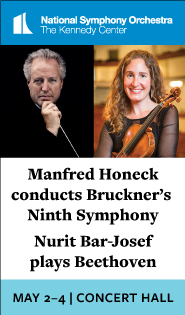Koopman goes for Baroque with National Symphony Orchestra

Ton Koopman conducted the National Symphony Orchestra in music of Bach and Handel Thursday night.
Since the rise of the historically informed performance movement, mainstream orchestras have tended to perform less and less Baroque music. The National Symphony Orchestra last performed three of the four works on their concert Thursday night in the Kennedy Center Concert Hall toward the end of the previous century. It took a visit by Dutch guest conductor Ton Koopman to turn the NSO back to these mostly familiar pieces by Bach and Handel.
Part of the problem large orchestras face with Baroque music is that historically minded ensembles have transformed listeners’ expectations. Without using historical instruments and having a deeper knowledge of period ornamentation, a compromise is often the best solution for non-specialist groups. For this performance Koopman scaled down the NSO, fielding just over thirty string players. The instrument were modern, but the lack of vibrato and more detached style of articulation offered a nod to the past.
The resulting string section was still larger than what Bach had at his disposal, for example, and they almost completely drowned out the color of the two oboes and single bassoon in the Orchestral Suite No. 3, which opened the program. Tellingly, Koopman further reduced the number of cellos and double-basses in the famous “Air” movement, shorn of almost all rubato and quite delicate and pretty as a result. The balance was much better against the three trumpets, brilliant in sound, especially principal trumpeter William Gerlach on the soaring top part.
Koopman is an all-body sort of conductor, but his head and shoulders did not necessarily mark the same placement of the beat, judging from the sometimes rough starts to movements on the first half. In Bach’s Brandenburg Concerto No. 1, principal horn player Abel Pereira negotiated the high horn parts with note-perfect precision. The horns, which sound off on clashing hunting calls in the first movement, are supposed to be like rude interlopers into the world of courtly gentility in this piece. Less refinement from them would have been welcome in the first movement.
Bach appended a mini-dance suite to the standard three movements of this concerto, and Koopman kept the various movements in proportion to each other in terms of tempo. The second trio, set therefore at a daunting pace, was a tour de force for the horns and the oboe section. Concertmaster Nurit Bar-Josef, so strong in romantic repertoire last week, sounded less at ease in her solos here, struggling at times with rhythm and intonation.
The horns were also front and center in Handel’s Concerto a due cori No. 3—or rather placed off to either side in pairs to enhance the piece’s antiphonal effects. The horns had no trouble making themselves heard, but the strings again obscured the softer oboes and bassoons in their divided choirs. Koopman brought out their sound for parts of some movements by not having the strings play, a nice way to feature the beautiful playing of the oboes and bassoons, as well as the horns.
The program concluded with Handel’s beloved Music for the Royal Fireworks, in the version with strings that the composer put together shortly after performing the work originally outdoors with only winds, brass, and percussion. The trumpet section was again gleaming on their martial parts, the music propelled by the driving rhythms of three percussion players on timpani and other drums. The often boisterous mass of sound in this work, heavy on the drums and bugles, recalled the outdoor origins of the piece but was a bit overwhelming for an indoor hall.
For the NSO to perform Baroque music more comfortably would likely require more than the occasional program with a period-conscious conductor. Perhaps the orchestra could explore establishing a regular residency with such a specialist, like the one Koopman had at the Cleveland Orchestra for few years.
The program will be repeated 8 p.m. Saturday in the Kennedy Center Concert Hall. kennedy-center.org; 202-467-4600.



Posted May 19, 2017 at 4:24 pm by Stuart
I was also at this performance, and completely agree with this critical assessment. I regret that I may have been a bit harsher on Nurit in my personal assessment of her performance than this review.
I did sit in the first tier, and must say that I didn’t have the same struggle as Mr. Downey did hearing the reeds (assuming he sat in lower levels), but completely agree on the balance points. My whole point for posting my response is to commend the reeds (at least from this listener) because I felt, from my vantage, the reeds played impeccably. I feel sorry the balance didn’t let their good work shine more.
Posted May 19, 2017 at 6:52 pm by Laura Youens
Richard and I enjoyed this concert, despite some reservations (and we agree totally with your last paragraph!). We thought some of the tempi out-Gardinered Gardiner. I loved the choice of repertoire, even though the pieces were familiar.